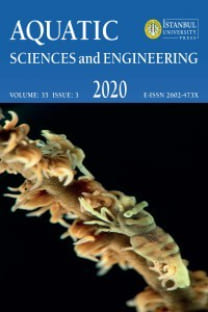Assessment of Lotic Macroinvertebrate Assemblage in the Oconaluftee River Basin in Cherokee, North Carolina
Assessment of Lotic Macroinvertebrate Assemblage in the Oconaluftee River Basin in Cherokee, North Carolina
Macroinvertebrate assemblage assessments act as useful analysis tools for assessing aquatic ecosystems health. These animals also serve as a base trophic level, acting as a source of food for many other aquatic organisms including fish and salamanders. Obtaining baseline data for monitoring aquatic insects and subsequent river health is vital to understand food chains and river ecological interactions. We sampled macroinvertebrate communities in two streams in the Oconaluftee River basin, in the Cherokee Qualla, North Carolina. Over 600 macroinvertebrates were collected and identified to the lowest taxonomic level possible, providing a macroinvertebrate profile of both riffle and run habitats. We identified over 35 genera and report on functional feeding groups, with biotic indices of water quality. Ephemeroptera, Plecoptera, and Trichoptera values varied, 21% and 65.43% for Raven’s Fork and 22% and 79.06% for the Oconaluftee rivers. This macroinvertebrate community suggests healthy stream aquatic insects and above average water quality, in spite of the urban land use found in the riparian zones of the sample sites. This research can be used as a baseline for future monitoring of aquatic streams in the area of the Cherokee Qualla.
Keywords:
Aquatic insects, freshwater biology water quality, biological surveys,
___
- Armitage, B.J., & Tennessen, K. J. (1984). The Trichoptera of Raven Fork, North Carolina- a stream subject to low pH events. Pp. 21-26, In J.C. Morse (Ed.), 4th International Symposium on Trichoptera. Dr. W. Junk Publishers, The Hague, Netherlands. google scholar
- Buria, L., Albarino, R., Villanueca, V. D., Modenutti, B., & Balseiro, E. (2007). Impact of exotic rainbow trout on the benthic macroinvertebrate community from Andean-Patagonian headwater streams. Fundamental and Applied Limnology,168,145-154. google scholar
- Cada, G. F., Loar, J. M., & Cox, D. K. (1987). Food and feeding preferences of Rainbow and Brown trout in southern Appalachian streams. The American Midland Naturalist, 117,374-385. google scholar
- Flebbe, P. A., & Dolloff, C. A. (1995). Trout use of woody debris and habitat in Appalachian wilderness streams of North Carolina. North American Journal of Fisheries Management, 15,579-590. google scholar
- Ghani, W. M., Rawi, C. S., Hamid, S. A., & Al-Shami, S. A. (2016). Efficiency of different sampling tools for aquatic macroinvertebrate collections in Malaysian streams. Tropical Life Sciences Research, 27,115-133. google scholar
- Giroux, F., Ovidio, M., Philippart, J. C., & Baras, E.. (2000). Relationship between the drift of macroinvertebrates and the activity of brown trout in a small stream. Journal of Fish Biology, 56,1248-1257. google scholar
- Hubert, W. A., & Rhodes, H. A. (1989). Food selection by brook trout in a subalpine stream. Hydrobiologica, 178,225-231. google scholar
- Lenat, D. R. (1988). Water quality assessment of streams using a qualitative collection method for benthic macroinvertebrates. Journal of the North American Benthological Society, 7, 222-233. google scholar
- Lenat, D. R. & J. K. Crawford. (1994). Effects of land use on water quality and aquatic biota of three North Carolina Piedmont streams. Hydrobiologica, 294,185-199. google scholar
- Loch, D. D., West, J. L., & Perlmutter, D. G. (1996). The effect of trout farm effluent on the taxa richness of benthic macroinvertebrates. Aquaculture, 147,37-55. google scholar
- Logan, P. & Brooker, M. P. (1983). The macroinvertebrate faunas of riffles and pools. Water Research, 17,263-270. google scholar
- Meissner, K., & Muotka, T. (2006). The role of trout in stream food webs: integrating evidence from field surveys and experiments. Journal of Animal Ecology, 75,421-433. google scholar
- Nickerson, M. A., Krysko, K., & Owen, R. D. (2002). Ecological status of the hellbender (Cryptobranchus alleganiensis) and the mudpuppy (Necturus maculosus) salamanders in the Great Smoky Mountains National Park. Journal of the North Carolina Academy of Science, 118, 27-34. google scholar
- Prakash, S., & Verma, A. K. (2022). Anthropogenic activities and biodiversity threats. International Journal of Biological Innovations, 4(1),94-103. google scholar
- Rhode, F. C., Arndt, R. G., Lindquist, D .G., & Parnell, J. F. (1994). Freshwater fishes of the Carolinas, Virginia, Maryland, and Delaware. University of North Carolina Press, Chappell Hill, 222p. google scholar
- Tooman, L.A. (1997). Tourism and development. Journal of Travel Research, 35,33-40. google scholar
- Walsh, C. (2005). Biological indicators of stream health using macroinvertebrate assemblage composition: a comparison of sensitivity to an urban gradient. Marine and Freshwater Research,57,37-47. google scholar
- Yayın Aralığı: Yılda 4 Sayı
- Başlangıç: 1987
- Yayıncı: İstanbul Üniversitesi
Sayıdaki Diğer Makaleler
Sierra B. BENFİELD, Shem UNGER
Yayan Mardiansyah ASSUYUTİ, Ahmad ZULFİKAR WİCAKSONO, Dasumiati DASUMİATİ, Khohirul HİDAYAH, Firdaus RAMADHAN, Alfan Farhan RİJALUDDİN, Dinda Rama HARİBOWO
Latife KÖKER, Emine Gözde ÖZBAYRAM, Ayça OĞUZ ÇAM, Reyhan AKÇAALAN, Meriç ALBAY
Cansu SARAÇOĞLU, Nur Eda TOPÇU
Ashraf I. G. ELHETAWY, Lydia M. VASİLYEVA, Nataliia SUDAKOVA, Mohamed M. ABDEL-RAHİM
Fish and Shellfish Diversity of Malam Beel, Bangladesh: Status, Trends, and Management Strategies
Mst. Jannatul FERDOUS, Mst. Armina SULTANA, Rasel MİA, Debasısh PANDIT, Mohd Golam Quader KHAN, Md. Samsul ALAM
